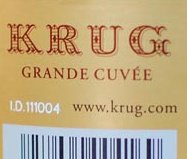1 February 2012 See also Eight (surprising) Krugs for breakfast.
For a long time the official line with Grande Cuvée, the principal product of Krug by far, was that it was blended to achieve consistency. But this was patently not the case. You can see my tasting notes on some disappointing cuvées on this site by putting Krug Grande Cuvée into the tasting notes search box (see this one, for example). I'm delighted that nowadays Olivier Krug says explicitly, 'consistency is not the aim'. They now admit there is variation between cuvées depending on the principal ingredient in the blend. Olivier told how at Krug they tasted six different Grandes Cuvées blind and, much to their surprise, the one they picked as their joint favourite was the one based on the disastrous vintage of 2001.
Informally within Krug they give each blend a name. The Grande Cuvée based on 1998 is called Equilibrium while that based on 2000 is known as Richesse. As Margareth Henriquez explains, 'These are all words of a Krugtionary we are building and we select them randomly to give our KGC's a name – in French – and not years or numbers for verticals or whatever it may be for the future.'
But identification of these different multi-vintage blends has been a real problem for those in the wine trade, for sommeliers, for consumers and for those of us charged with reporting our tasting notes on them. For those without intimate understanding of the tiny lot numbers printed on bottles, all Grande Cuvées looked the same.
I have been calling for some sort of explicit identification (such as disgorgement date) of champagnes not carrying a vintage year since the early 1990s, when, believe it or not, I wrote a column for the Wine Spectator. More recently Antonio Galloni of The Wine Advocate has also been asking that all champagne bottlings be uniquely identified, and has even been refusing to review those that are not.
I'm delighted to say that Krug have at last decided to put a clearly identifiable, if not exactly explicit, code on all their back labels, clearly enough for us all to see. 
The first three digits of this numerical code are the most important. If the number begins 310, it means that the wine was disgorged in the third quarter of 2010. 412 would signify that the wine was disgorged in the fourth quarter of 2012. The example above and right, coded 111004, was disgorged in the first quarter of 2011 and so on. It's not rocket science but nor is it hugely intuitive. Margareth Henriquez is adamant that the code should never explicitly specify the principal vintage on which a particular Grande Cuvée was based because that would be antithetical to the multi-vintage ethos. What they are promising is that their (frustratingly slow to load) website www.krug.com will provide full details of each cuvée via these codes.
It may not be a perfect system but it is certainly a step in the right direction and one that I hope will be followed by more and more champagne houses – not just for their de luxe cuvées but for their regular non-vintage blends, too.














